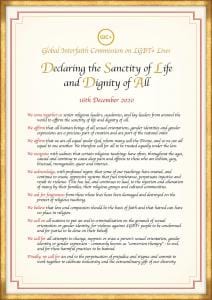In recent years, the debate around LGBTQ+ inclusion in various Christian denominations has become central to conversations about the future of Christianity. Many Protestant denomination like the United Methodist Church have found themselves at an impasse, contemplating an official schism over their position on LGBTQ+ inclusion. This year, Pope Francis made international headlines a number of times for increasingly affirming statements about the rights and dignity of LGBTQ+ people, ranging from approval of civil unions to calling on Catholics to suspend judgement of their LGBTQ+ siblings. Every time the Holy Father spoke, he was met with fierce critique from traditionalists within the Church as well as high praise from progressives both within the Catholic world and outside of it.
Much of the division on the inclusion and affirmation of LGBTQ+ lives and love stem from differing interpretations of seven primary sections of Holy Scripture that seem to either condemn same-sex sexual behavior or establish a “norm” for how romantic relationships should be established. Throughout the course of my career as a theologian and minister, I have spent a great deal of time studying these passages of scripture, examining the original language, diving deep into the culture and context of the authors of these texts, and researching the evolution of these texts in modern translations of the Holy Bible.
After years of prayerful study, I was led to the conclusion that the seven so-called “Clobber Passages” had very little to do with modern, loving, consensual, same-sex relationships. In fact, the behaviors being condemned in most of the passages have to do with exploitation and sexual abuse, something the Church has tragically become known well for, leading me to wonder if there may have been any impact on these behaviors if these passages had been translated and understood correctly. What follows in this article is a brief summary of my interpretation of these infamous passages, rooted in Christian tradition, the original language, and the culture of the Biblical world. It is my hope that these brief summaries will help to shed light on what the Bible is actually seeking to condemn and help provoke prayerful conversations about how Christians should think about and relate to the LGBTQ+ community going forward.
The Ordering of Creation in Genesis 1-2:
The Genesis creation account should be understood as a metaphor for the creation of the world and of human relationships. It begins with a God who creates a human in God’s own image. God then realizes that it is not good for the human to be alone- meaning without someone like him. At the end of the second chapter of Genesis, we see a differentiation of the gender identity of Adam and Eve as male and female, and they enter into a covenantal relationship to support one another and procreate through that would later be called “marriage”. Any relationship centered on a consensual commitment to sacrificial love for the good of another should be seen as a holy relationship, and any attempt to break that commitment is seen as less than God’s desire for humanity. Covenant relationships are vital to human flourishing- whether between the opposite sex or the same sex.
The Story of Sodom and Gomorrah in Genesis 18-19
As we read about the state of affairs in ancient Sodom and Gomorrah in the book of Genesis, we learn that the people of these cities were proud, selfish, and inhospitable. This stands in stark contrast to the code of hospitality commanded by God, which instructs his people to welcome foreigners with open arms. Lot represents this posture well, offering to welcome the angelic visitors, cook them a meal, and ensure their safety. Later in the Hebrew Bible, this inhospitable posture of the rest of the city, who sought to harm and abuse the angelic visitors, is declared to be the sin for which Sodom is destroyed: “Behold, this was the sin of your sister Sodom: she and her daughter had pride, excess of food, and prosperous ease, but did not aid the poor and the needy.”[1] The Scripture is clear that Sodom and Gomorrah were destroyed because of their pride which led them to be selfish and inhospitable, rather than aiding the poor and the needy in their midst.[2]
Leviticus 18:22 and Leviticus 20:13
Both of these condemnations of same-sex sexual behavior in Leviticus are directly preceded by reminders that these rules were meant to keep the Jewish people from being like the surrounding dominant polytheistic cultures.[3] These cultures often practiced ritual sex offered to a variety of deities and engaged in practices such as using conquered people as sexual slaves[4]. This makes it clear that the cultural context of the Leviticus passage does not reference loving, consensual same-sex relationships, but relationships rooted in idolatry or exploitation, both of which should be rightly condemned. The word abomination used in Leviticus 18:22 further proves this contextual understanding, because the Hebrew word toevah refers to a ritual uncleanness rather than something objectively, morally wrong.
Romans 1:26-27
In Romans 1, St. Paul describes the descent of the Roman culture into pagan idolatry. He begins by saying that the Roman people once knew the true and living God, and then turn to pagan idolatry, which lead them down a path of grave immorality. St. Paul is writing to a specific people in a specific context. After all, not all of humanity has followed the same trajectory Paul outlines – it was unique to the Greco-Roman context and culture. Same-sex sexual relations were fairly common in the Greco-Roman world that Paul lived in[5], and most of the expressions of homosexual sex were linked to various forms of pagan worship[6], prostitution, abuse of slaves, or pederasty.[7] All of these are linked to exploitation and pagan idolatry and never to loving, consensual, same-sex relationships.
1 Corinthians 6:9-10
The words Paul uses in 1 Corinthians 6:9 which is mistranslated as “male prostitutes” and “sodomites” are the Greek terms malakoi and aresenakoiti. The word “arsenekoiti” literally translates as “man bed” and most scholars agree that this again likely refers to some form of ritual rape or temple prostitution. It is unlikely, contextually, to assume that it referred to “homosexuality” as the committed sexual relationship between two consenting partners of the same sex. This word also did not exist in the Greek language until Paul created it in this text. If Paul was explicitly seeking to condemn homosexual relationships in any of his writings, he could have used one of the over twenty more common Greek words for same-sex relationships and behaviors that his readers would have immediately understood.
1 Timothy 1:9-10
In 1 Corinthians 6:9-10 and in 1 Timothy 1:10, St. Paul uses the word malakoi, which is a common Greek word which translates in modern vernacular as “effeminate men” or “boys”. In the ancient Greco-Roman world in particular anything considered effeminate was thought to be weak and undesirable. In the Greco-Roman culture would have seen any man who allowed himself to be penetrated sexually by another man to be willfully giving up his masculinity, thus making himself “malakos”, which would have been a reason for him to be marginalized in a Patriarchal culture.[8] There is virtually no debate among scholars that malakoi in St. Paul’s letters simply meant “effeminate man” and likely did not refer to consensual same-sex sexual relationships.
The Holy Bible is a powerful and profound text. It should be treated with reverence and with academic rigor. Unfortunately, Christians have become far too accustomed at taking these ancient words at face value without doing the hard work of studying the text and “rightly dividing the word of truth.” (2 Timothy 2:15) When one deeply examines what the Bible actually teaches on the topic of LGBTQ+ identities, it becomes clear that the Scriptures say nothing about such relationships. This is not because they didn’t exist- the most certainly did in the ancient Greco-Roman world of Jesus. But instead of speaking a clear condemnation of such relationships, Jesus chose to remain silent. Perhaps it would be wise for Christians not to speak with certainty on that which the Lord said nothing. Perhaps we should instead seek to heed the clear teaching of Jesus who taught us that all of the Scriptures can best be summed up in a simple command- “love”. As the Scriptures teach, love can do no wrong and love is the evidence of God’s presence. So, whether were speaking of heterosexual love or LGBTQ+ love, we would do well to embrace it as the divine gift that it is.
[1] Ezekiel 16:49-50
[2] Choon-Leong Seow, “Textual Orientation”, in Brawley Biblical Ethics and Homosexuality, 22.
[3] Leviticus 18:2-3, Leviticus 20:2
[4] Walsh, “Leviticus 18:22 and 20:13: Who is Doing What to Whom?,” Journal of Biblical Literature, 120/2 (2001) pg 208
[5] Dover, Greek Homosexuality (Cambridge, MA. Harvard University, 1978)
[6] “Convivia” was a common Roman dinner party that often involved drunken orgies to honor pagan gods.
[7] Pederasty refers to an ancient practice of an older man taking a pre-pubescent boy a sort of apprentice, which also included engaging in sexual relations with that boy. This practice did not threaten the patriarchal norms of the day because the boys used in these relationships were not yet considered “masculine” because they had no facial hair and were not fully grown.
[8] Key, Perry, “Malakos and Arsenokoitês” (Westar Institute, 2020) https://www.westarinstitute.org/wp-content/uploads/2020/05/Malakoi-Arsenokoitai-3.1.pdf











